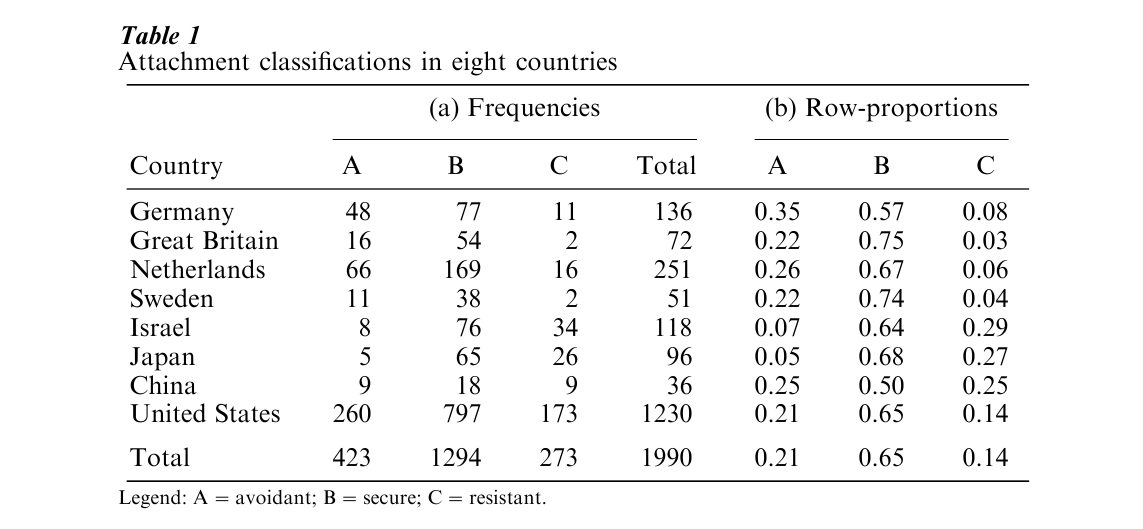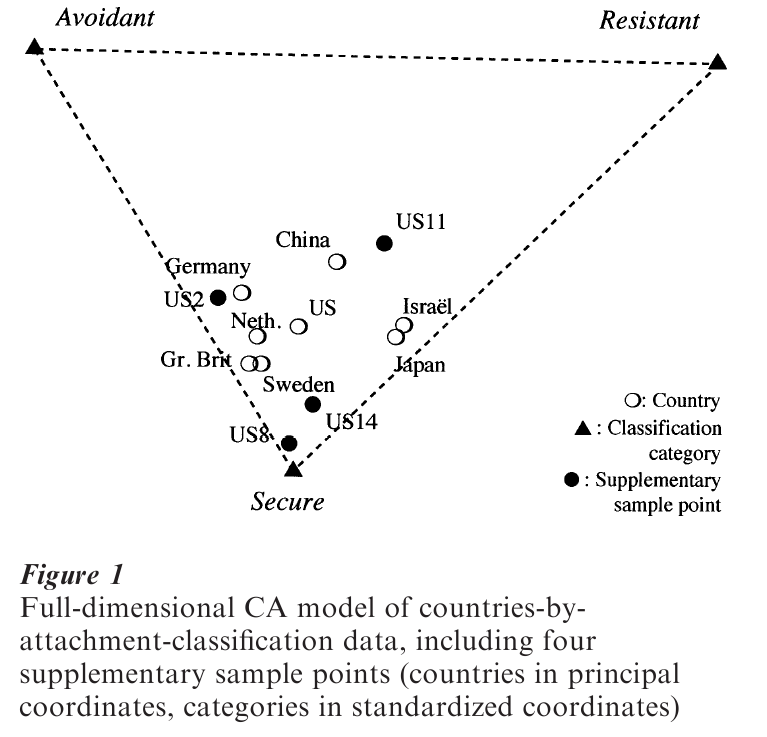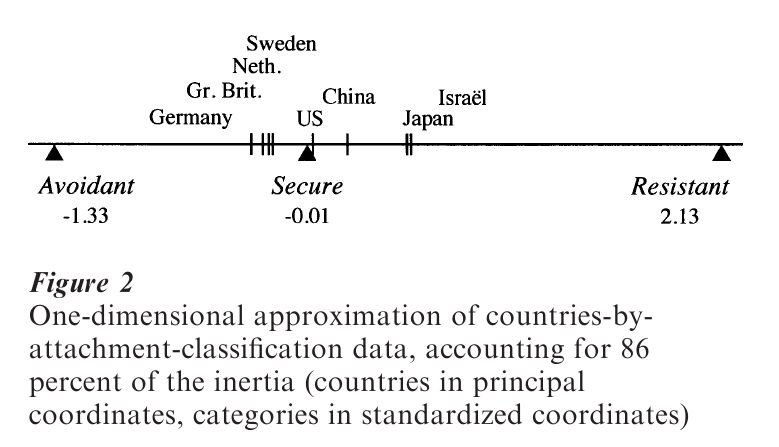Sample Correspondence Analysis Research Paper. Browse other research paper examples and check the list of research paper topics for more inspiration. iResearchNet offers academic assignment help for students all over the world: writing from scratch, editing, proofreading, problem solving, from essays to dissertations, from humanities to STEM. We offer full confidentiality, safe payment, originality, and money-back guarantee. Secure your academic success with our risk-free services.
Correspondence analysis (CA) handles research data that have the form of rectangular tables containing indications of association strength between row entries and column entries (correspondence tables). The association measure is assumed to be some non-negative quantity. Cells of a correspondence table may contain transition or confusion frequencies (forming a contingency table), binary choices among dyads of persons, for example in sociometric studies, or preference judgments for options by experts on a rating scale from weak to strong endorsement. In other words, response scales have to be unipolar, ranging from zero, indicating absence of association, to some maximal positive value, indicating strongest possible association. Although the scope of application of CA is very broad, it has been most typically used and developed as a method for analyzing contingency tables. Hence some core concepts refer to the frequency domain, even though other justifications of the method exist.
Academic Writing, Editing, Proofreading, And Problem Solving Services
Get 10% OFF with 24START discount code
1. Row And Column Profiles
As an illustration consider the eight discrete distributions in Table 1(a) taken from van Ijzendoorn and Kroonenberg (1988). Several studies using the Strange Situation paradigm (Ainsworth et al. 1978) in various countries seemed to show marked cross-cultural differences in distributions of attachment classifications. Most of the studies used a classic three-fold attachment classification into Avoidant (A), Secure (B), and Resistant (C). These three types characterize the enduring socio-emotional bond between child and regular care-giver. To examine the cross-cultural heterogeneity more closely, the authors selected 32 samples from eight countries, representing 1,990 Strange Situation classifications, which have been aggregated in Table 1 to the level of countries. To study similarities and differences of distributions regardless of sample size, it is necessary to divide frequencies by their row total (see Table 1(b)). A row of proportions is called a row profile; analogously, a column profile is formed by dividing the cell frequencies in a column by the column total. The natural comparison standard to assess a row profile against is the marginal profile of the columns, that is, each of the column totals divided by n, the grand total. Similarly, column profiles are first compared with the marginal profile of the rows, that is, each of the row totals divided by n. From the row profiles it is immediately clear that Germany has a relatively large proportion of Avoidant, for example, Great Britain and Sweden have an overrepresentation of Secure and an under-representation of Resistant, while Israel, Japan, and China have an overrepresentation of Resistant.

The aim of CA is to assess similarities and differences of row profiles (and/or column profiles), not only with respect to their marginal profile, but also amongst each other, by constructing a parsimonious approximation of the cell frequencies. The approximation consists of decomposing the correspondence table into one or more components, which through graphical display allows a deeper insight into the original categories by suggesting specific groupings, orderings, or more complicated arrangements.
2. Deviations From Independence
The decomposition of CA has two major parts: one consisting of a multiplicative combination of row and column proportions, the usual form used in studying statistical independence, the other consisting of row– column interaction effects. To be more explicit, the following notation is introduced.
The frequency in cell (i, j ) of the contingency table is denoted by nij, where the categories of the row variable A have range i=1, …, I and the categories of the column variable B have range j=1, …, I, and the categories of the column variable B have range j=1, …, J. Row totals are defined as ni+ = Σjnij and column totals as n+j = Σinij. We also have the grand total n++ = Σini+ = Σjn+j, frequently denoted simply by n. To keep the results invariant under changes in sample size, CA works with the quantities pij = nij/n, each of which is the (estimated) probability mass in the cell (i, j) of the bivariate distribution of A and B, ri =ni+/ n, the relative mass of row profile i, and cj= n+j /n, the relative mass of column profile j. The CA decomposition is based on the tautologous identity

where the quantities qij are defined as qij =( pij-ricj)/(rici). The qij are standardized deviations from independence: if the two variables A and B are independent, we have pij = ricj and every qij would vanish. Dependences between A and B show up specifically in the qij: categories i and j are more strongly associated than expected under independence when qij > 0, and less strongly when qij >0. Spatial and graphical representations that result from CA are representations of the deviations [qij], not of the data [ pij] themselves.
3. Basic Geometric Model
In the CA model each row profile initially is a point ai in a subspace of dimensionality J-1, with coordinates aij =nij /ni+. Analogously, each column profile is a point bj with coordinates bij= nij /n+j in another subspace, of dimensionality I-1. The total spread of the points in space is measured by their inertia J, a concept from physics defined as (for the row points)

where c is the point with coordinates cj that represents the marginal profile of the columns. The function ||·||C−1 defined implicitly in Eqn. (2) is a Euclidean norm with weights 1/cj. It downweights column differences associated with large column mass, because large frequencies tend to be less reliable. There is a parallel expression of inertia for column points, which can be shown to yield the same numerical value of J. In both cases, large overall differences among the distributions will lead to a spread-out configuration of points with large J , while small overall differences will correspond to a tight concentration of points around their center of gravity, with small J.
Dividing the usual chi-squared statistic by n, so that lack of homogeneity (or independence) is measured regardless of sample size, we have the equality

In statistics, χ2/n is known as Pearson’s mean square contingency. The r elation in Eqn. (3) between the chi- squared statistic χ2 and the weighted sum of squared distances towards the center of gravity J defined in Eqn. (2) is the reason that one speaks of heterogeneity being measured in the chi-squared metric ||·||C−1 .
Mutual distances between row profiles are determined in the same chi-squared metric, and hence called chi-squared distances. For two profiles i and k we have

with again an analogous expression for the column points. In Eqn. (4) columns with small marginal frequency are seen to contribute more to overall lack of similarity than columns with large marginal frequency. For an exhaustive treatment of the geometry of CA, see Benzecri (1992, pt. I).
4. Weighted Least Squares Approximation
Low-dimensional CA approximations of the full-dimensional model are obtained by least squares, where each cell is weighted by the product of the row and column masses (see Andersen 1990). The least squares solution consists of two sets of standardized coordinates, zit(A) and zjt(B), where t indexes the components, with t having range t=1, …, min (I-1, J-1). The components are ordered by the size of a third set of quantities σt, called singular values. Stan dardized coordinates zit(A) have the property Σiriz2it(A)=1; analogously, for zjt(B) we have Σjcjzjt2(B) =1. Also, the coordinates are in deviation from their weighted mean and uncorrelated across different values of t. The singular values σt indicate the relative importance of component t in the approximation of [qij]. Practical CA solutions are obtained by dropping components associated with small singular values.
Graphical displays are based upon a mapping from ai to yi(A), a model point with principal coordinates defined as yit(A) =σtzit(A), with t =1, …, T (some chosen dimensionality). Principal coordinates for column points are yjt(B) =σtzjt(B). For maximal dimensionality T*=min(I-1, J-1) it can be shown that

i.e., Euclidean distances among model points are equal to chi-squared distances among profile points. In approximations with T<T* the former are always smaller than latter (see Meulman 1982).
5. Some Important Additional Concepts

The CA solution for the attachment data is shown in Fig. 1, in which the row points are plotted as open circles. Since in this example we have T*=2, the model exactly reproduces the data ( χ2=102.42 with df4, J=0.051). Approximation in T=1 implies projecting all points on the horizontal axis, which here accounts for 86 percent of the inertia (see Fig. 2). With the US and China forming the center, the largest contrast in both solutions is between the Western European countries vs. Israel and Japan, while Fig. 1 shows a second contrast between China and Germany versus Great Britain and Sweden related to deviations in their Secure classifications.

5.1 Transition Formulas
Row points and column points reside in two different but intimately related spaces. Their coordinates are connected by the equations


These equations are called transition formulas, since they show how the principal coordinates, e.g., yit(A), of one set of points can be obtained from the standardized coordinates, e.g., zjt(B), of the other set of points: by weighted averaging with the data as coefficients. If the correspondence table is binary, principal coordinates are plain averages of standardized coordinates, and CA becomes equivalent to the method of reciprocal averages, which has firm roots in psychometrics (Horst 1935, Guttman 1941), with continued research under the name dual scaling (Nishisato 1994).
5.2 Joint Plot And Coherent Normalization
In Fig. 1 the country points are plotted in principal coordinates, so that their Euclidean distances are equal to the chi-squared distance of Eqn. (5). The distances between the country markings along the line in Fig. 2 approximate these chi-squared distances rather closely. The plots also show the three attachment classes in standardized coordinates. Super-position of row and column points forms a joint plot, also called a ‘biplot,’ which is easily interpretable due to the transition formulas. For example, Germany is located relatively close to Avoidant, because its location is a weighted average of the three attachment points, weighted with [0.35, 0.57, 0.08] rather than with the average profile [0.21, 0.65, 0.14], which forms the center of the plot. It is also possible to (re)scale the coordinates so as to make the two clouds of points more evenly mixed, but this has to be done with some care (Heiser and Meulman 1983). Rescaling is coherent if we choose points xi(A) and xj(B ) with coordinates xit(A) = σαt zit(A) and xjt(B) =σt1–a zit(B) for any α, because it remains true that xi(A)Txj(B)=qij. But it should be noted that we no longer approximate chi-squared distance unless α=0 or α=1.
5.3 Supplementary Points
It can be useful to add new profiles to an existing joint plot. These supplementary points are easily obtained if scaling is chosen as α=0 or α=1, since then Eqns. (6) or (7) can be used to find coordinates. In Fig. 1, points were added for four divergent individual US studies, showing that there is at least as much variation within the US as between countries. While US2 closely resembles the total German group, US11 is much more like China, for example.
6. Extensions And Applications
The case of more than two variables, called multiple CA, was pioneered by Guttman (1941). Under the name ‘homogeneity analysis,’ Gifi (1990) generalized Guttman’s technique to ordinal data, and introduced extensions based on partitioning of variables. Green-acre (1984) and Lebart et al. (1984) bridged the gap between the early French work and the international literature. The edited volume of Greenacre and Blasius (1994) contains social science applications, versions of CA with various constraints, and versions that achieve clustering of categories.
Bibliography:
- Ainsworth M D S, Blehar M C, Waters E, Wall S 1978 Patterns of Attachment, a Psychological Study of the Strange Situation. Erlbaum, Hillsdale, NJ
- Andersen E B 1990 The Statistical Analysis of Categorical Data. Springer, Berlin
- Benzecri J-P 1992 Correspondence Analysis Handbook. Dekker, New York
- Gifi A 1990 Nonlinear Multivariate Analysis. Wiley, New York
- Greenacre M J 1984 Theory and Applications of Correspondence Analysis. Academic, London
- Greenacre M, Blasius J (eds.) 1994 Correspondence Analysis in the Social Sciences. Academic, London
- Guttman L 1941 The quantification of a class of attributes: A theory and method of scale contribution. In: Horst P et al. (eds.) The Prediction of Personal Adjustment. Social Science Research Council, New York, pp. 319–48
- Heiser W J, Meulman J J 1983 Analyzing rectangular tables with joint and constrained multidimensional scaling. Journal of Econometrics 22: 139–67
- Horst P 1935 Measuring complex attitudes. Journal of Social Psychology 6: 369–74
- Lebart L, Morineau A, Warwick K M 1984 Multivariate Descriptive Statistical Analysis: Correspondence Analysis and Related Techniques for Large Matrices. Wiley, New York
- Meulman J J 1982 Homogeneity Analysis of Incomplete Data. DSWO, Leiden, The Netherlands
- Nishisato S 1994 Elements of Dual Scaling: An Introduction to Practical Data Analysis. Erlbaum, IIillsdale, NJ
- van Ijzendoorn M H, Kroonenberg P M 1988 Cross-cultural patterns of attachment: a meta-analysis of the strange situation. Child Development 59: 147–56




